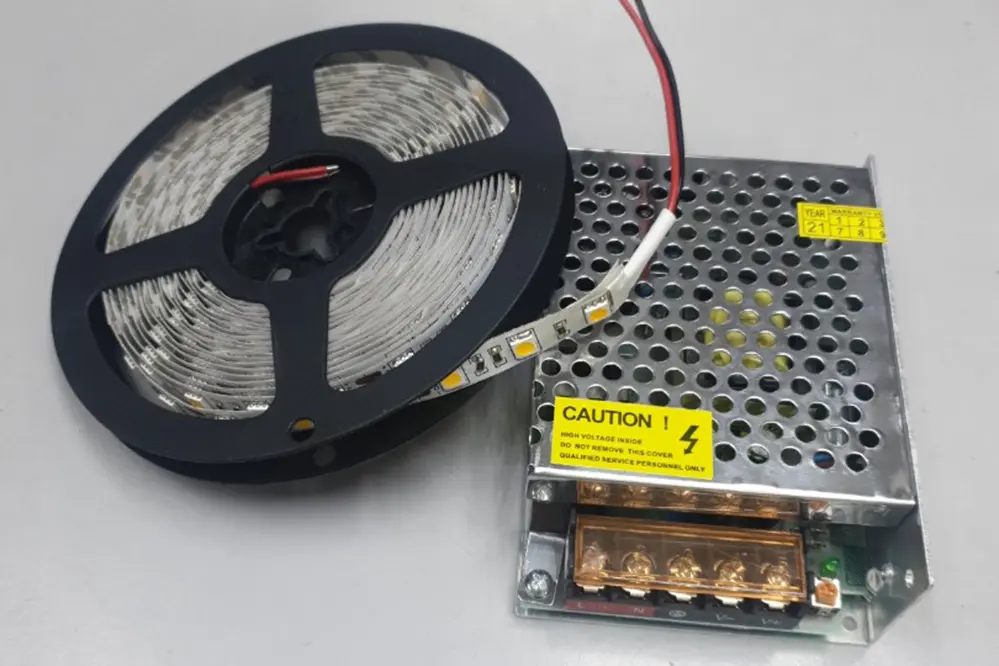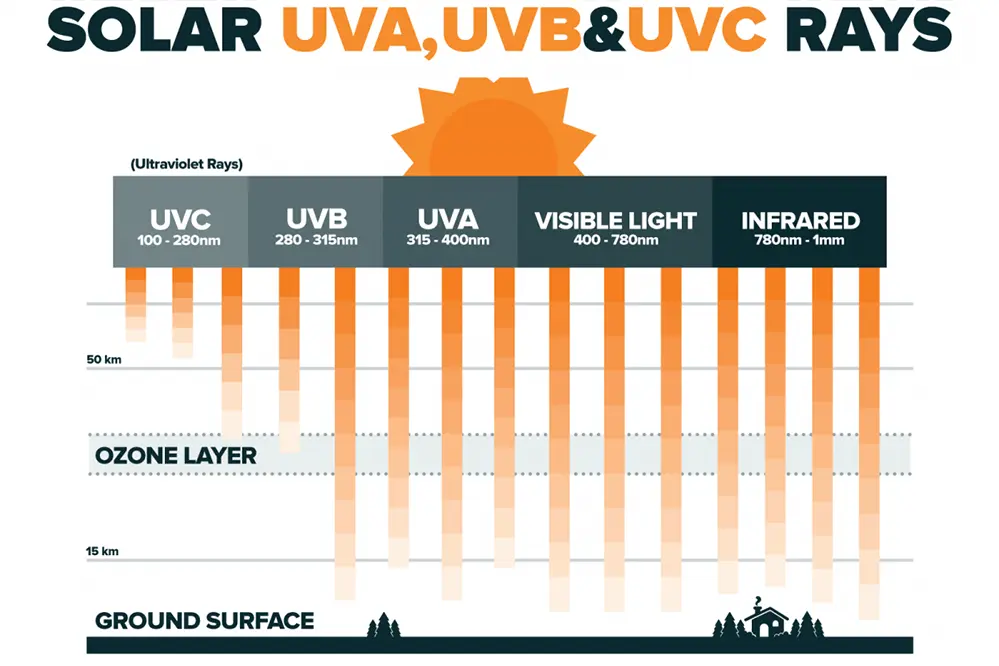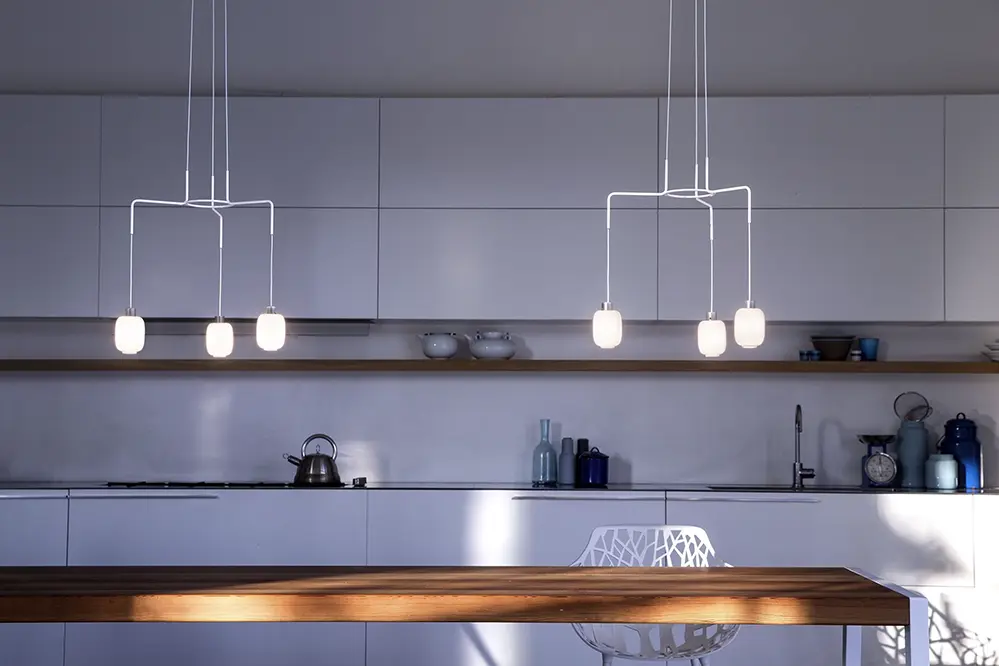Are you wondering if LED strips really need a power supply? Look no further! In this blog post, we have the answer to your question and all the information you need to make an informed decision.
LED strips unequivocally require a dedicated power supply that matches their voltage and current requirements. Neglecting this critical detail can lead to suboptimal performance and potential damage to the lighting system. Choosing the right power supply ensures longevity, reliability, and optimal lighting outcomes.
Discover the importance of power supply selection, potential hazards of using incompatible sources, and key considerations for a robust lighting solution. Don’t miss out on the expert insights that will help you achieve the best results with your LED strip lighting.
Understanding LED Strip Basics
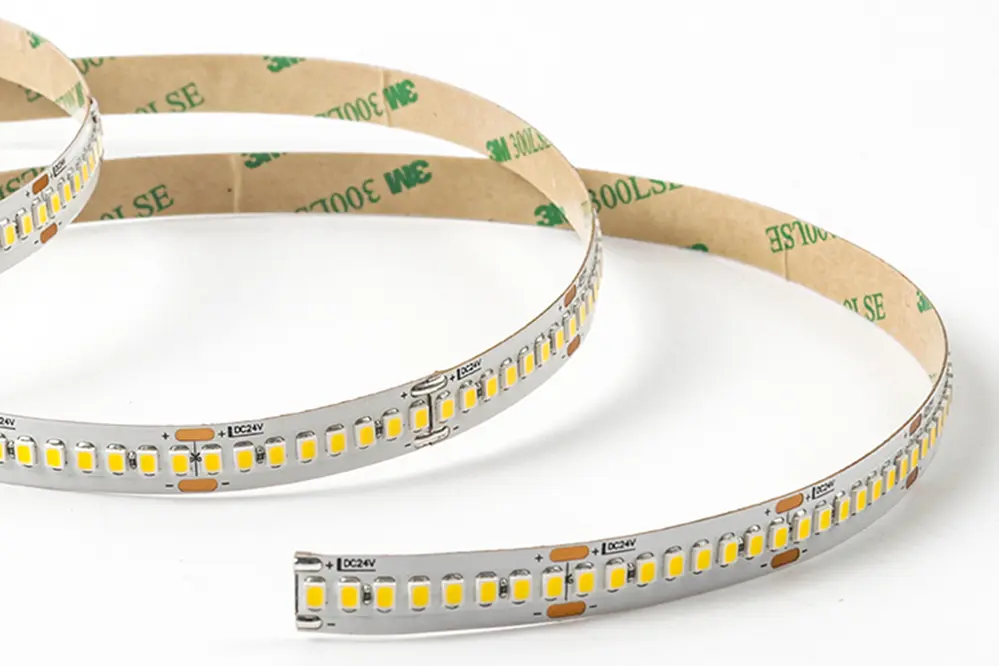
LED strips are a compilation of small, light-emitting diodes (LEDs) aligned on a flexible circuit board. Given their design variation from traditional fixtures, one might question whether a power source is necessary—yes, unequivocally it is.
Unlike incandescent bulbs, LED strips cannot simply be connected to a wall socket; they require a carefully calibrated power supply to convert electrical energy into efficient, bright illumination. This supply ensures the voltage matches the specified needs of the strip, maintaining the integrity and longevity of the LEDs.
The term “power supply” encompasses both plug-in adapters and hardwired transformers, each appropriate depending on the application at hand. A correct power source spells the difference between a dazzling display and a non-functional LED array.
Essential Components of LED Strips
LED strips necessitate a power source, which is fundamental to their operation. Without the right power supply, these efficient illuminators will fail to perform optimally.
An accurate power supply not only energizes the LEDs but also maintains voltage stability, essential for the longevity and luminous efficacy of LED strips. Consequently, ensuring the voltage corresponds with the LED strip’s requirements is crucial.
LED strips use direct current, making a power supply indispensable for alternating current environments.
Power supplies for LED strips come in various forms: plug-in adapters for simplicity or hardwired solutions for integrated systems. Selecting the appropriate type is pivotal for seamless functionality and enduring LED performance.
How Power Impacts LED Performance
Power quality profoundly influences the integrity and performance of LED strip lighting.
- Voltage Consistency ensures smooth operation and prevents fluctuations that can lead to LED degradation.
- Adequate Current is crucial to avoid overdriving the LEDs, which can result in overheating and reduced lifespan.
- Power Supply Capacity should match the LED strip’s energy consumption to maintain optimal brightness and efficiency.
- Thermal Management benefits from proper power delivery, as excessive current can increase heat generation, impairing LED performance.
Insufficient power leads to dim performance and potential flickering.
Proper power delivery enhances LED lifespan and ensures maximum luminous output.
Power Supply Necessity for LEDs

Indeed, every LED strip necessitates a power supply to convert high-voltage alternating current (AC) to low-voltage direct current (DC), suitable for its operation.
As a luminary technician would attest, LED strips vary in voltage requirements—commonly 12V or 24V—and without a compatible power source, the LEDs cannot function as intended, compromising both brightness and longevity.
Selecting a power unit with the correct voltage and ample amperage is indispensable to maintain the luminous efficacy and durability of LED strip lights.
Voltage Requirements and Safety
The voltage specification of LED strips is paramount for safe and efficient operation.
- Proper Voltage Matching is essential to prevent overloading the LED strip and risking electrical hazards.
- Under Voltage Operation can lead to suboptimal performance and increased susceptibility to voltage fluctuations.
- Over Voltage Exposure can irreversibly damage LEDs, leading to premature failure and potential safety risks.
- Regulated Power Supply ensures a consistent voltage supply, which is critical for the longevity of LED strips.
- Certified Components from reputable manufacturers guarantee compliance with safety standards and reliability.
Highly regulated power ensures the LEDs operate within their safe parameters.
Adherence to voltage requirements safeguards against electrical mishaps and enhances the lifespan of LED strips.
Power Sources: Adapters vs. Batteries
LED strips necessitate an appropriate power source.
Adapters are frequently the go-to for powering LED strips. They convert alternating current (AC) from your wall outlet into direct current (DC), the form of power required by most LED strips. This translation ensures the delivery of stable voltage, which is essential for the longevity and consistent performance of LED lighting. Conversely, there can be size and installation limitations depending on the power source’s design.
A battery can energize portable LED installations.
Yet, the lifespan of batteries is finite – they will deplete over time and require either replacement or recharging. Batteries may be conducive to flexible installations where wiring to AC power is impractical – however, they might not provide continuous, long-term power for extensive or high-brightness LED strip applications.
The power supply decision must align with operational demands and installation constraints.
With technological advancements, there are now smart options that blend the benefits of both. Updated power solutions, introduced early in 2023, harness innovative energy-harvesting techniques, potentially challenging traditional notions of power supply for LED strips. These systems may offer alternative power sources that capture environmental energy, providing cost-effective and sustainable options for powering LED strips.
Selecting the Right Power Supply
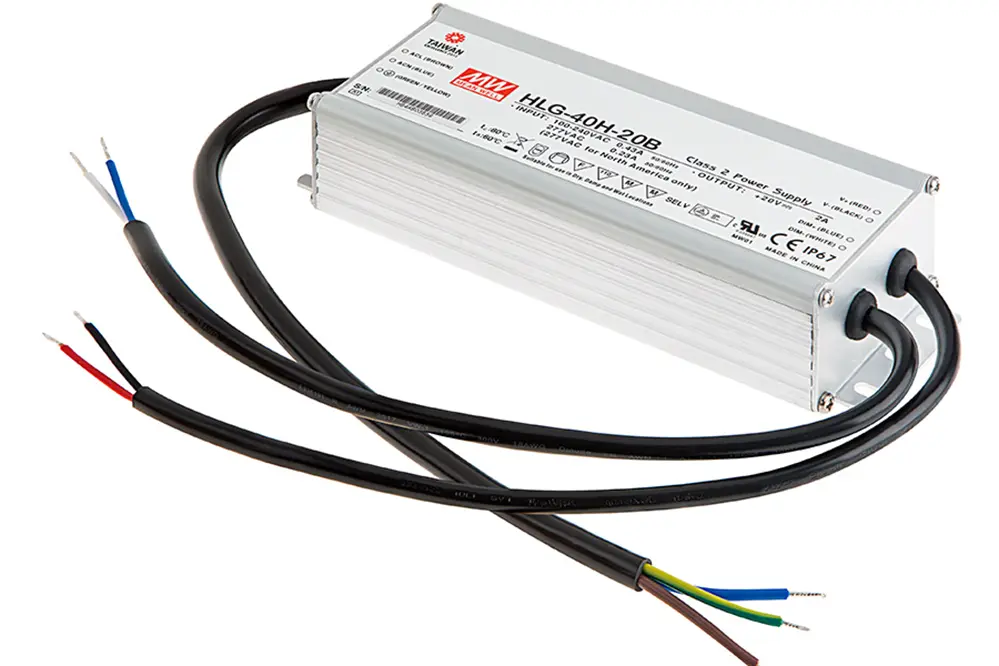
When evaluating a power supply, the voltage and current specifications are critical determinants. Choose a power supply that matches the voltage rating of the LED strip; an incompatible voltage can lead to suboptimal performance or damage. Equally important is ensuring that the current output sufficiently satisfies the amperage needs of your LED strip to prevent overheating and potential failure.
In the case of LED strips, it is prudent to invest in a power supply with a “buffer” in its capacity, meaning it can supply more power than the LED strip’s maximum load. This overhead accounts for potential additional strain and can extend the life of the power supply. Additionally, the quality of the power supply is paramount. A higher-grade unit will likely offer more consistent voltage regulation and better resistance to fluctuations in power, thus protecting the lifespan of your LED strip installation.
Calculating the Power Needs
To accurately establish the power requirements of an LED strip, begin by ascertaining its voltage and maximum current rating. This information is typically found on the strip or in the accompanying documentation. Awareness of the total length of the LED strip in use is crucial as it influences the total amperage draw.
Power requirements are directly derived from the strip’s rated amperage per meter. Multiplying this figure by the total length in meters provides the aggregate amperage demand. Precision in these calculations is paramount, as even slight discrepancies can lead to unsuitable power specifications, which may compromise the installation’s integrity and safety.
The calculated amperage must then be multiplied by the LED strip’s voltage to ascertain the total wattage required. This wattage denotes the minimum power output needed from your power supply. When selecting a power supply, it is advisable to add a 20% overhead to the required wattage, ensuring ample headroom for the system.
This practice mitigates potential issues from voltage drops or variances in power consumption that may occur during the operation of the LED Strip. It acts as a safeguard to accommodate temporary spikes in power usage without overloading the power supply.
In scenarios that involve dimming or dynamic lighting effects, considering peak power requirements is essential. These functionalities may induce higher power consumption, thus necessitating a calculation that incorporates these variables into the total power budget.
Ultimately, the success of LED strip installations hinges on the precision of these power calculations. Accurate determination of power needs ensures optimal performance and longevity of the LED strips, and protects against electrical hazards.
Matching Power Supply to LED Specifications
Selecting the correct power supply is critical to ensure the longevity and proper functioning of LED strips.
- Calculate Total Wattage: Sum the wattage of all LED strips that will be connected to a single power supply.
- Incorporate Overhead: Add at least a 20% overhead to the calculated wattage to accommodate potential power surges and ensure reliable operation.
- Verify Voltage Match: Ensure the voltage of the power supply matches the voltage specification of the LED strip to avoid underpowering or damaging the LEDs.
- Consider Amperage: Check that the power supply can provide the necessary amperage for the total length of the LED strip.
- Assess Power Supply Quality: Opt for power supplies with protections against overload, short circuits, and thermal cutoff to guarantee a safe installation.Overlooking these criteria can lead to inadequate performance or premature failure of the LED components.
Adherence to these guidelines is indispensable for the sustenance and efficacy of LED lighting systems.
Installation Tips and Best Practices
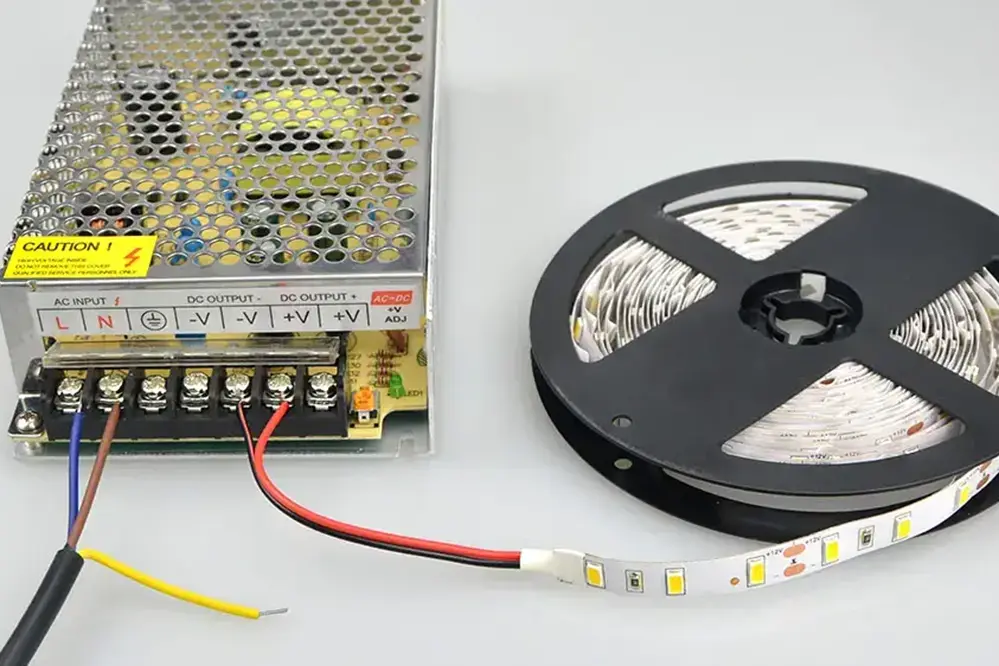
When installing LED strips, one must proceed with meticulous attention to detail. After ensuring the power supply adheres to the strip’s specifications, it’s crucial to plan the layout of the strip to avoid excessive bending or stretching, which can damage the circuitry. For optimal adherence, the surface should be clean, dry, and smooth; an imperfect surface can lead to inconsistent attachment. Moreover, during installation, avoid direct contact with the LED components themselves – use the designated points of contact. This reduces the risk of electrostatic discharge, which can be detrimental to LED strips. Remember to also account for heat dissipation: LED strips should not be enclosed in airtight spaces without proper ventilation, as excessive heat can markedly reduce their lifespan. Lastly, when possible, utilise connectors and cable clamps to streamline cable management, as this enhances the overall aesthetics and mitigates potential electrical hazards.
Step-by-Step Power Connection Guide
Ensure compatibility by matching your LED strip’s voltage and power requirements with a suitable power supply. Selection is pivotal to prevent overloading or underpowering your LED installation.
Calculate the total wattage needed for your strips to select an appropriate power supply rating. Underscoring this will safeguard against potential electrical issues.
When wiring, connect the positive lead to the positive terminal of the power supply and the negative lead to the negative terminal. Verify the polarity to avert any electrical mishaps. Use a multimeter to ensure proper voltage is present before connecting your LED strips.
For installations that encompass multiple LED strips, ensure each strip is powered adequately by employing a power supply that can handle the cumulative load. If necessary, use amplifiers or repeaters to stabilize the electrical current across extended runs. In complex setups, consider consulting a certified electrician to validate compliance with local electrical codes.
Avoiding Common Power Supply Mistakes
Understand your system’s voltage compatibility.
Oversights in voltage matching can lead to catastrophic failures. When selecting a power supply, acknowledge the voltage requirements of your LED strips. Ensuring compatibility reduces risks of electrical shorts or potential fire hazards. Additionally, there is a need to be cognizant of the variance in voltage that may occur over long distances, which can lead to dimming or flickering of LEDs.
Always factor in power reserve capacity.
Selecting a supply with a tight power threshold can spell trouble. Allowing an overhead of power – typically recommended to be around 20% over the total wattage required – affords a safeguard against surges or fluctuations which may occur under variable loads or temperatures.
Verify power supply’s load before extending LED strips.
Inadequate power distribution results in uneven lighting. To prevent this, assess the load of your current power supply before adding more LED strips. Failure to do this can lead to overloading and, thus, premature power supply failure.
Ensure thermal management in LED power supply design.
The longevity of LED strips is inextricably linked to thermal management, especially pertaining to power supplies. Selecting a power supply with a robust thermal design, conforming to the latest standards as of 2023, maintains optimal operating temperatures. Poorly managed thermal loads can reduce efficiency, lifespan, and overall performance of both the power supply and the LED strips it feeds.
FAQs
Will LED strips function without a power supply?
No, LED strips require a power source to operate. They cannot emit light without the necessary electrical power to drive the LEDs, which is typically provided by a compatible power supply.
How do I choose the right power supply for my LED strip?
Selecting an appropriate power supply necessitates knowing the voltage and current requirements of your LED strip. Ensure the power supply’s voltage matches the strip’s voltage and that its wattage exceeds the total wattage of the strips by at least 20%, to account for power surges or fluctuations.
Can I use any power supply with my LED strips?
Not all power supplies are compatible with every LED strip. It’s crucial to match the power supply’s output voltage with your LED strip’s voltage requirement. An incorrect voltage can lead to insufficient illumination or potentially damage the LEDs.
What happens if my power supply is too weak for my LED strip?
Utilizing a power supply that lacks sufficient wattage for your LED strip will lead to inadequate brightness and can cause the power supply to overheat and fail prematurely. To avoid this, always verify the capacity of the power supply against the power requirements of your LED strips.
How do LED strips get power?
LED strips get power through a power source, such as a battery or an electrical outlet. This power source provides the necessary electrical current to the LED strip.
Once the LED strip is connected to the power source, the electrical current flows through the strip’s circuitry. The circuitry consists of multiple components, including resistors, capacitors, and integrated circuits, which help regulate the flow of electricity.
The power input of the LED strip is typically marked by specific labeled pins or connectors. These pins or connectors provide a secure and reliable connection to the power source, ensuring that the electrical current reaches the LED strip.
It is important to note that LED strips require the appropriate voltage and current to function properly. Each LED strip has specific power requirements, and using an incompatible power source can damage the strip or result in inefficient operation. Therefore, it is crucial to consult the manufacturer’s specifications or seek guidance from a lighting professional to ensure that the LED strip is powered correctly.
What type of power supply do LED strips need?
LED strips typically require a specific type of power supply to function properly. These power supplies are known as LED drivers or LED transformers.
LED drivers are designed to convert the standard AC (alternating current) voltage from the mains power supply into a lower and more stable DC (direct current) voltage that is suitable for powering LED strips. This conversion is necessary because LEDs operate on low voltage DC power and cannot be directly connected to the mains power supply.
LED drivers come in various forms, such as constant voltage drivers and constant current drivers. The choice of driver depends on the specific requirements of the LED strips being used.
Constant voltage drivers are commonly used for LED strips that operate on a fixed voltage, such as 12V or 24V. These drivers provide a constant voltage output to ensure a steady and reliable power supply for the LED strips.
Constant current drivers, on the other hand, are used for LED strips that require a specific amount of current to operate effectively. These drivers deliver a constant current output, adjusting the voltage as needed to maintain the desired current level.
It is important to select the appropriate LED driver for your LED strips to ensure optimal performance and longevity. The power supply must match the voltage and current requirements of the LED strips to avoid overloading or underpowering them, which can lead to premature failure or poor lighting performance.
In summary, LED strips need a specific type of power supply, known as an LED driver, to convert the standard AC voltage into a suitable DC voltage for powering the LEDs. The choice of driver depends on the voltage and current requirements of the LED strips being used. Selecting the correct driver is crucial for ensuring proper functioning and longevity of the LED strips.
Can LED strips be powered by batteries?
LED strips can indeed be powered by batteries. In recent years, with advancements in LED technology, battery-powered LED strips have become increasingly popular. LED strips are designed to be energy-efficient, and this makes them well-suited for battery-powered applications.
In 2016, for example, a company called Lumastrobe introduced a battery-powered LED strip that can be used for various lighting purposes. This LED strip is compact and portable, making it ideal for situations where traditional power sources are not readily available.
Today, there are various battery-powered LED strip options available on the market. These strips typically utilize low voltage LEDs and are powered by batteries, such as AA or AAA batteries. They often come with built-in battery packs or can be connected to external battery packs for extended use.
Battery-powered LED strips are commonly used for decorative lighting, portable displays, and DIY projects where flexibility and ease of installation are important. They provide a hassle-free lighting solution that can be easily installed and moved around without the need for electrical outlets or wiring.
Overall, battery-powered LED strips offer a convenient way to add lighting to various settings, making them a popular choice among lighting enthusiasts and professionals alike.
Should LED strips be connected to a dimmer?
LED strips can be connected to a dimmer to control their brightness. This allows users to adjust the light output according to their preference or specific lighting needs. By connecting LED strips to a dimmer, you have the capability to create different lighting scenes, set desired ambiance, or even conserve energy by dimming the lights when full brightness is not necessary.
When connecting LED strips to a dimmer, it is important to ensure compatibility between the dimmer switch and the LED strip. LED strips are typically low-voltage devices and require a compatible dimmer that is designed specifically for LED lighting. Using an incompatible dimmer switch may result in flickering or erratic behavior of the LED strips, or even cause damage to the lights themselves.
LED strips can be connected to a variety of dimmer switches, such as wall-mounted dimmers, remote-controlled dimmers, or even smart home automation systems. Each type of dimmer will have its own specific installation requirements and compatibility considerations. It is important to consult the manufacturer’s instructions or seek professional advice to ensure proper installation and operation of the dimmer switch with LED strips.
In conclusion, connecting LED strips to a dimmer provides flexibility and control over the lighting environment. However, it is crucial to select a compatible dimmer switch and properly install it to ensure optimal performance and longevity of the LED strips. By doing so, users can enjoy customizable lighting experiences and achieve the desired level of brightness for their specific lighting applications.
Conclusion
LED strips require a dedicated power supply that matches their voltage and current requirements. Neglecting this detail can lead to suboptimal performance and potential damage. Choosing the right power supply ensures longevity and reliability. Using an incompatible power source can cause overheating, reduced lifespan, and safety hazards. Consider voltage compatibility and wattage overhead for a robust lighting solution. Paying attention to power supply specifications distinguishes a professional approach. A correctly rated power supply is crucial for optimal lighting outcomes, performance, durability, and safety.
If you are in need of high-quality LED strip lights and LED neon strips, we recommend reaching out to Unitop, a professional Chinese manufacturer. With their expertise and commitment to excellence, they can provide you with top-notch products that meet your specific requirements. Don’t compromise on the quality of your lighting solution, contact Unitop today for all your LED strip lighting needs.
